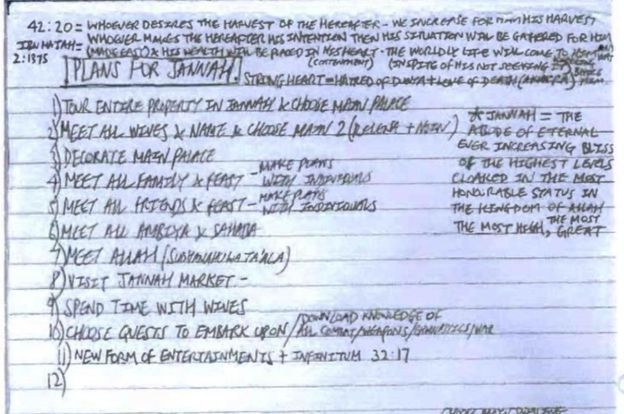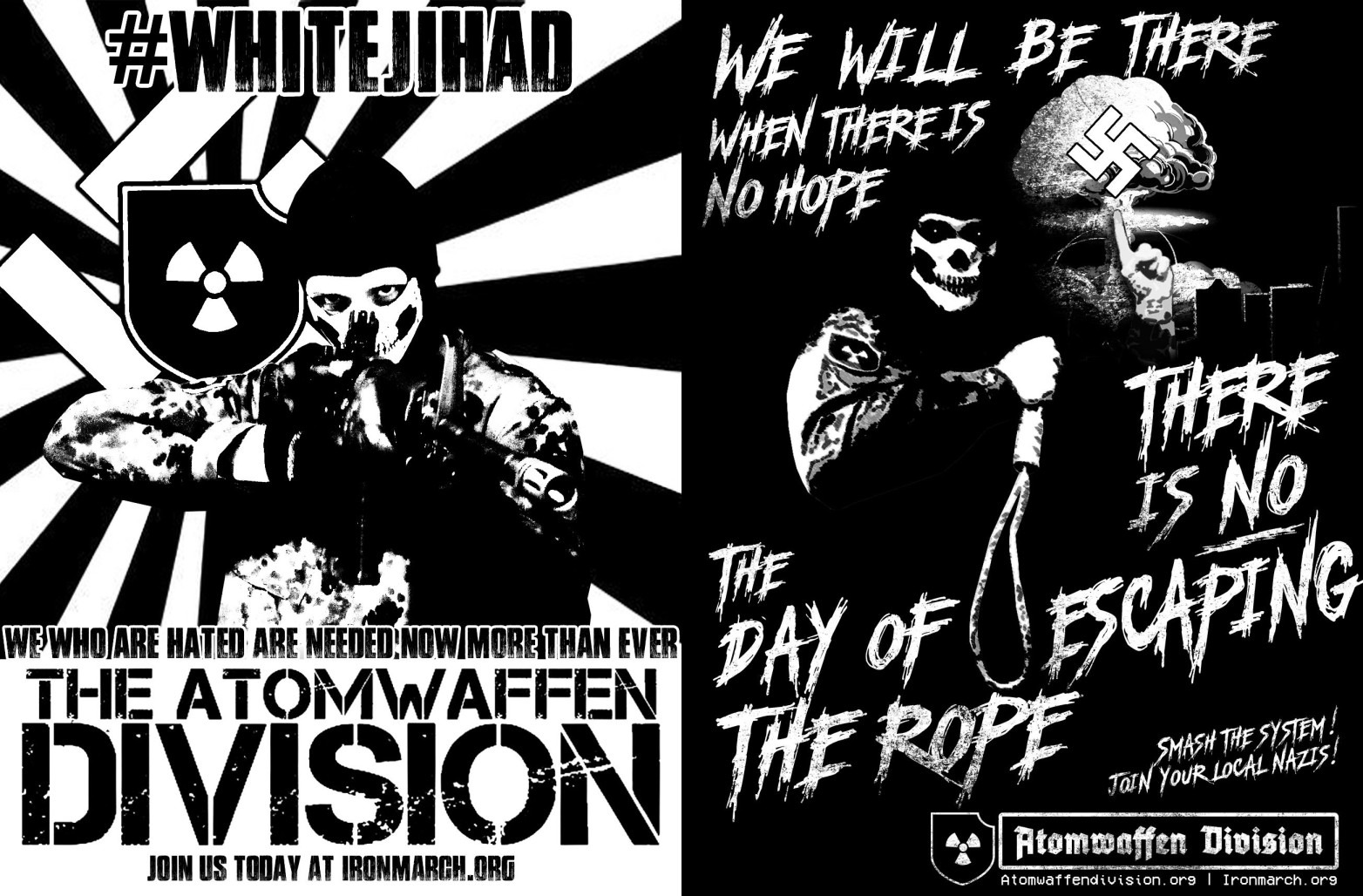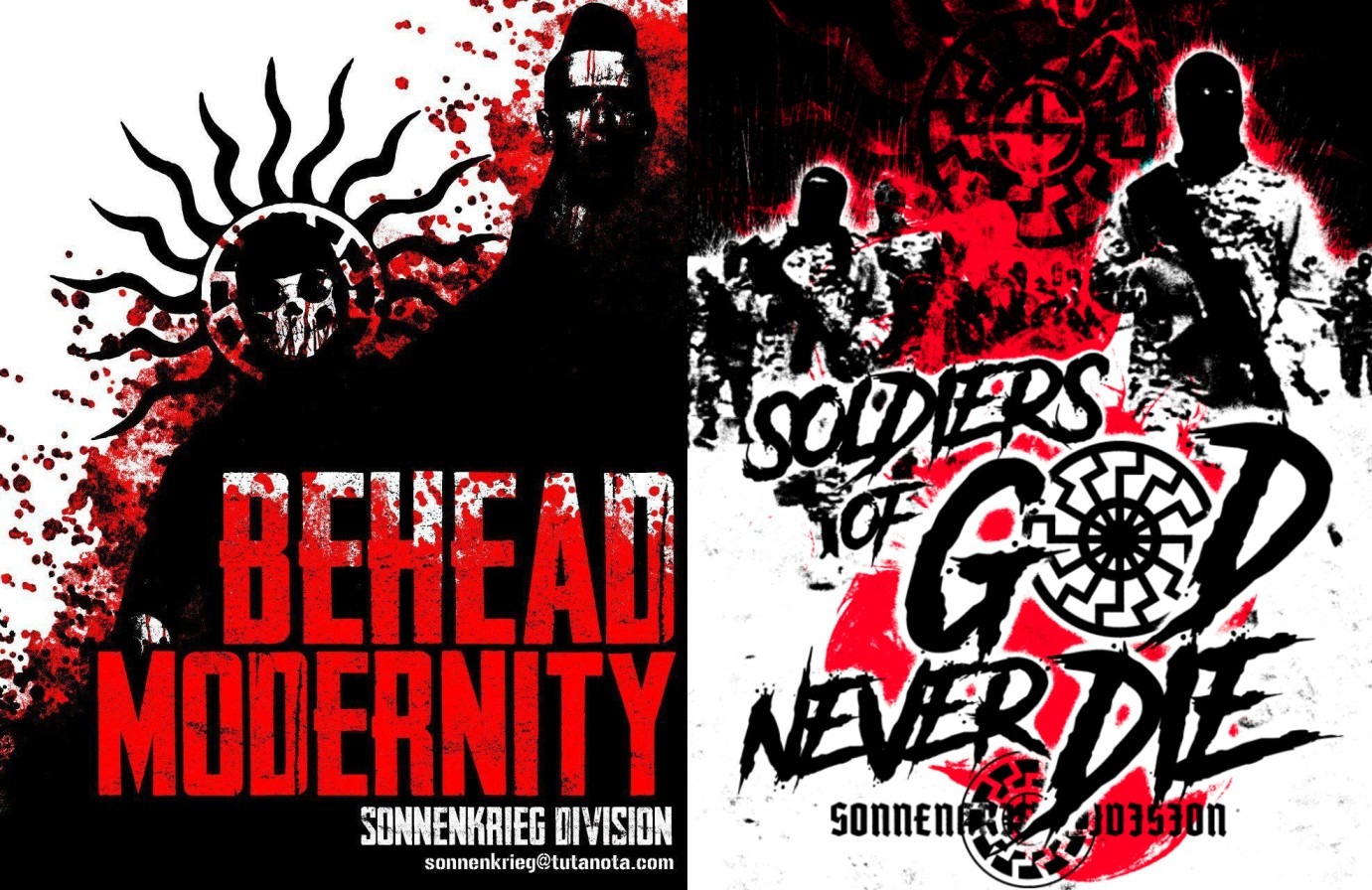War Is Peace: The Symbiosis Between Islamists and Neo-Nazis

By Gurwinder Bhogal
Staff Writer
28/2/2020

On January 3rd a man in a Parisian park screamed “Allahu Akbar!” and stabbed three people before being shot dead.
A month later, the same thing happened again, this time in Streatham, London, when a man screamed “Allahu Akbar!” and stabbed two people before being shot dead.
Then, a week ago, a man carried out a shooting spree at two shisha bars in Hanau, Germany, murdering nine, before killing his mother and then himself. He did not shout “Allahu Akbar!” because he was a neo-Nazi.
The media are calling these “lone wolf” attacks, but this view is based on an outdated understanding of terrorism. Not only were the two jihadi knifemen working together, they were also working with the neo-Nazi gunman; whether they knew it or not, all were part of a growing movement furthering a single grand scheme – one potentially more catastrophic than any terrorist attack.
Not only were the two jihadi knifemen working together, they were also working with the neo-Nazi gunman.
I witnessed the early stages of this grand scheme while living in the notorious town of Luton. Once voted the UK’s worst place to live, it has a low terraced skyline punctuated by factory smokestacks and mosque minarets. The typical street is a parade of contrasts: street signs are written in both English and Urdu, Islamic bookstores stand next to infidel bookmakers, haute couture shops have rows of mannequins draped in burqas. Some streets contain Islamic charity bins for the deposit of clothing, while others contain amnesty bins for the deposit of guns and knives. Occasionally, the adhan (call to prayer) resounds from minaret loudspeakers, to awkwardly accompany the hip-hop basslines that boom from souped-up hatchbacks.

These incongruities are largely due to the town having a large Kashmiri-immigrant population, which in the 1990s made it a prime target of jihadi recruiters like Omar Bakri Mohammed, whose terrorist organization al-Muhajiroun has since made Luton one of its primary strongholds.
Al-Muhajiroun members have been implicated in almost every major jihadi terror plot in the UK, but unlike al-Qaeda, the group’s main purpose has always been less about sowing fear than sowing outrage. Dressed in traditional Islamic thawbs and equipped with loudspeakers, they would set up dawah (proselytization) stalls on busy streets and scream apocalyptic threats through beards that resembled frozen explosions. At night, when the streets were empty, they would sneak around vandalizing monuments of Western culture, such as spray-painting burqas over the female models plastered on billboards.
The first to react to al-Muhajiroun’s provocations were the local football hooligans known as the MIGs (Men In Gear). They would frequently enter the Muslim neighborhood of Bury Park en route to and from the football stadium, and, drunk on booze and nationalism, would attack the dawah stalls, flinging bacon, tugging hijabs, yelling anti-Muslim slurs, and occasionally punching people.
The Luton leader of al-Muhajiroun, Mohammed Istiak Alamgir, known locally as Saiful Islam (Sword of Islam) lived right next to the stadium. He would carefully note the most egregious actions of the MIGs, and then exaggerate them further to incite outrage among the town’s Muslims.
He would carefully note the most egregious actions of the MIGs, and then exaggerate them further to incite outrage among the town’s Muslims.
Alamgir and his gang would also spread tales of Muslim oppression by Western soldiers in Iraq and Afghanistan, drawing on real examples like the Abu Ghraib abuse scandal. Foreign policy was a sore spot for al-Muhajiroun, so when the group heard that soldiers of the 2nd Battalion Royal Anglian Regiment, who had just returned from Basra, were going to be parading through Luton in March 2009, they planned a surprise welcome.
On the day of the parade, as the soldiers strode through a light blizzard of confetti along a corridor of flag-waving patriots, thirty al-Muhajiroun members leapt out to confront them, chanting “Rapists!” “Butchers of Basra!” and “British soldiers go to hell!”
The protest was picked up by national media, which stoked a backlash against Luton’s Muslim community. Over the next two weeks there was an escalation in local anti-Muslim violence, which included Luton’s mayor Lakhbir Singh being mistaken for a Muslim and kicked in the back, and Luton Islamic Centre being set on fire.
Soon enough, the MIGs and other nationalist groups reacted to al-Muhajiroun’s provocations by forming the far-right “counter-jihad” group, the English Defence League (EDL), which was led by Luton local Tommy Robinson (real name Stephen Lennon). At Robinson’s direction the EDL held a series of anti-Islam marches throughout Luton and the country.

In February 2011, after Luton jihadi Taimour al-Abdaly carried out a suicide bombing in Stockholm, thousands of EDL members and other anti-Islam activists descended on Luton, waving English flags and chanting “Muslim bombers off our streets!” Robinson then gave a speech in which, like his enemy Alamgir, he painted a picture of the West at war with Islam. A few EDL members handed out crudely printed flyers, including one with a silhouette of a mosque whose minarets had been drawn to look like fangs.
More attacks on Muslims followed, and once again Alamgir used them to fire up locals and reinforce the West vs Islam narrative. One local Islamist, Zahid Iqbal, began plotting to kill EDL members, but later changed his plans to attacking an army base with a toy-car bomb. Another local Islamist, Alamgir’s close friend Abu Rahin Aziz, stabbed an EDL supporter in the eye with a pen before skipping bail to become an ISIS bombmaker in Syria, where he was killed in a drone strike.
In October 2013 Robinson announced he was stepping down as EDL leader (he claims in his book he was paid to do so by the counterextremism think-tank Quilliam Foundation). With its figurehead gone, the EDL began to decline, but by then it didn’t matter, because the group’s game of mutual provocation with al-Muhajiroun had spawned a host of other anti-Muslim street gangs, like Britain First, which immediately filled the vacuum, invading mosques and interrogating imams, and organizing “Christian Patrols” which marched through Luton waving Union Jacks and broadsword-sized crucifixes.
According to Farasat Latif, a senior imam at the Luton Islamic Centre, the actions of Britain First and the EDL infuriated a regular attendant of the mosque, Khalid Masood, who told Latif he wanted to kill them. But in the end, Masood chose a different target altogether: random strangers. In March 2017 he drove his car into a crowd on London Bridge, killing four and injuring fifty, before crashing into a fence surrounding the Palace of Westminster, where he fatally stabbed a police officer and was then shot dead.
Shortly afterward, Luton man Filip Golon Bednarczyk uploaded a YouTube video of himself cutting up a Britain First membership card. For him, the group was not doing enough against Islam. He began preparing a bomb to mass-murder Muslims, but in December 2019 his plot was uncovered by police and he was arrested.
Another local who was recently discovered to be planning mass-murder was the jihadi Mohiussunnath Chowdhury, who was convicted on terrorism charges earlier this month. In his possession was found a list of things to do in Jannah (Islamic paradise), which included “decorate main palace” and “choose quests to embark on.” Also in Chowdhury’s possession was a signed collector’s edition copy of Tommy Robinson’s book Mohammed’s Koran – Why Muslims Kill for Islam, which he much admired for its fundamentalist portrayal of his religion.

Chowdhury’s to-do list for when he got to heaven. Bewitched by Islamic tales of the afterlife, he drew further inspiration from anti-Islam activists who emphasized the importance of martyrdom in Islam, like Tommy Robinson.
Chowdhury, a man inspired to violence by both jihadis and the far-right, is the consummation of Luton’s 20 year tit-for-tat, the child of the union between the EDL and al-Muhajiroun narratives, which drew strength from each other for so long that now they have much in common. Both taught Chowdhury and others the same fundamental point: that Islam was necessarily violent, and that it was at war with the West.
Both taught the same fundamental point: that Islam was necessarily violent, and that it was at war with the West.
The tendency for jihadis and the far-right to reinforce each other’s narratives, sometimes referred to as “reciprocal radicalization,” was identified as early as 2006 in a paper by Roger Eatwell, who called the process “cumulative extremism,” noting how “different forms of extremism are constructed in discourse by other extremists.” In Luton’s case, al-Muhajiroun helped construct the EDL, who helped strengthen al-Muhajiroun, who then helped to radicalize the EDL further until its members resorted to violence.
It should be noted, however, that the provocations by al-Muhajiroun always produced far greater reactions than those of the EDL and Britain First. In the 24 hours following the murder of Lee Rigby by jihadis, the EDL tripled its number of Facebook followers. And shortly after the 2017 London Bridge attacks, police registered a 500% rise in hate crimes against Muslims. Provocations by the far-right were not nearly as effective at driving people to Islamism.
One reason al-Muhajiroun was better at provocation than far-right groups was that it was willing to go much further to provoke, often committing actual terrorism in the attempt. The EDL and Britain First, meanwhile, were relatively law-abiding, generally confining their activities to marches and picketing, with only the occasional bout of assault or vandalism.
What this meant was that Islamists radicalized right-wingers more than the other way round. And through this asymmetry, the jihadis intensified the hatred of groups like the EDL and Britain First until they birthed a new opposition that, to the jihadis’ delight, was just as vicious as they were: neo-Nazi accelerationists.
Watching the EDL’s war with Islamists had been a Norwegian man named Anders Breivik. He wrote, “it is highly advisable to structure any street protest organization after the English Defence League (EDL) model.” However, for Breivik the EDL was too soft to match groups like al-Muhajiroun: “The EDL, although having noble intentions are in fact dangerously naïve.” Breivik believed that the counter-jihad movement should draw from the tactics of their most ruthless enemy – al-Qaeda – as well as from neo-Nazism. And so, in July 2011, he detonated a van-bomb, killing eight people, before shooting another 69 dead.
In the UK, a young man named Benjamin Raymond called Breivik “the hero Norway deserves”. Together with disenchanted EDL member Ashley Bell, Raymond set to work on the manifesto of a new group, National Action, which, unlike the EDL and Britain First, would embrace violence, oppose democracy, equality, and multiracialism, and employ a new strategy – accelerationism – the attempt to achieve revolution by hastening the decay of the liberal order.
The group was quick to show how serious it was; in 2015 National Action member Zack Davies attacked a Sikh man in a grocery store with a machete to “avenge” the killing of Lee Rigby. When the pro-immigration politician Jo Cox was murdered by ultranationalist Thomas Mair, the official National Action Twitter account celebrated the killing, stating: “Don’t let this man’s sacrifice go in vain,” and “Only 649 MPs to go #WhiteJihad.”
After National Action was found to be behind a slew of terrorist plots, the UK government proscribed the group, making it the first white supremacist organization to be banned in the UK since the Second World War. But, as with al-Muhajiroun’s ban, this didn’t end its activities and simply led it to operate under different names. To make matters worse, by 2016 National Action’s ideology of neo-Nazi accelerationism had already caught on across the world, spawning dozens of new terror groups, the most notorious being the US-based Atomwaffen Division.

Propaganda posters of the Atomwaffen Division. Note the cues taken from ISIS: the term “white jihad” in the left picture, and in the right picture the spectral figure pointing upward in a mock ISIS hand-sign.
Neo-Nazi accelerationists are the next stage in the convergence of Islamism and the far-right via reciprocal radicalization, sharing more in common with jihadis than with the EDL and Britain First. Both tribes of terrorist draw their worldviews from politicized mythologies: the jihadis from Salafi Islam as interpreted by the revolutionary theorist Sayyid Qutb, and the neo-Nazi accelerationists from Aryanism as interpreted by revolutionaries like “Hitler’s High Priestess” Savitri Devi.
These competing mythologies, Qutbi and neo-Nazi, ultimately teach the same thing: that there once existed an Eden where everything was pure. For jihadis this Eden is the “Salaf,” the first three generations of Muslims, who allegedly lived pure Islamic lives. For neo-Nazi accelerationists the Eden is “Thule” or “Hyperborea,” a lost civilization of whites who allegedly lived pure Aryan lives.
Both Qutbis and neo-Nazis consider their Eden to have become corrupted by a secret cabal of Jews, who polluted it with things like democracy and multiculturalism. And both groups believe that the only way to return civilization to its past purity is through holy war: what Qutbis call “jihad” and Nazi accelerationists call “RaHoWa” (Racial Holy War) or, increasingly, “white jihad.”
Both groups believe that the only way to return civilization to its past purity is through holy war.
The ideologies of the two groups are so similar that there is frequent cross-pollination between them. National Action takes many of its beliefs from the Satanist cult Order of Nine Angles, whose Grand Master, David Myatt, was once an al-Muhajiroun-affiliated jihadi who went by the name of Abdul Aziz ibn Myatt. Likewise, former neo-Nazis have gone on to embrace Qutbism and become jihadis, notably the Atomwaffen member Devin Arthurs who declared himself a “Salafi National Socialist” before murdering his two Nazi roommates for ridiculing his conversion.
The ease with which ideas translate between Nazi-accelerationism and jihadism attests to their ideological similarity. But even more dangerous is the two groups’ pragmatic similarity.
Modern jihadi tactics are based on a small number of key texts, the most important of which is arguably Abu Bakr Naji’s The Management of Savagery. This book draws on the theories of the influential al-Qaeda tactician Mustafa Setmariam Nasar to argue for a decentralized accelerationist approach to jihad, and explains how “vexation operations” can be used to provoke the enemies of Islam into retaliating against Muslims in order to bolster the narrative of Muslim oppression, deepen divisions between Muslims and infidels, and destabilize society. In other words, the book explains how the process of reciprocal radicalization can be actively utilized to destroy infidel civilizations.
Like the jihadi accelerationists, the Nazi accelerationists also have a key tactical text – James Mason’s Siege – which echoes Naji’s book so closely the two could pass as loose translations of each other. Like The Management of Savagery, Siege explains how reciprocal radicalization can be weaponized to bring about apocalyptic war, even going so far as recommending that neo-Nazis vote for far-left politicians in order to create a more hostile environment for Aryan people, setting the conditions for a violent backlash of white fury.
Since neo-Nazi accelerationists have modelled their organization and operation on jihadi groups, they recognize that their tactics perfectly complement those of the jihadis, forming a symbiosis of hate in which both sides perpetually reinforce one another like a mise-en-abyme: two mirrors infinitely reflecting each other. Roman Wolf, communications specialist of the Nazi-accelerationist group The Base (the English term for “al-Qaeda”), retweeted before his account was suspended:
Our enemies will accelerate our situation as they are intent on achieving their goals. We cannot halt this acceleration. We can however speed it up even further — every act of resistance by whites causes a further reaction by our enemies.
New Zealand Nazi Brenton Tarrant took this advice to heart when he shot up two mosques, killing 50 people. His manifesto had an entire chapter dedicated to accelerationism, in which he describes how strengthening antagonistic forces can create a breaking point for society, leading to its collapse.
Tarrant’s attack was intended to sow terror in the hearts of Muslims, but more than that it was intended to sow outrage, to get Muslims to retaliate against whites. It worked; ISIS members heard of the attack and immediately exploited it for their own ends. “Where is revenge, O zealous [Muslims]?” they asked, adding: “The language of blood is not confronted with the language of surrender…but with the language of blood.” Just over a month later, jihadis set off a series of bombs at luxury hotels in Sri Lanka, killing more than 300 and injuring more than 500. A senior Sri Lankan minister said the bombings were revenge for Tarrant’s attack. Whether or not this is true, it is clear that jihadis and neo-Nazi accelerationists, having complementary ideologies and complementary methods – and an awareness of this fact – are effectively in cahoots.

Propaganda posters of Atomwaffen’s UK branch, the Sonnenkrieg Division, once again drawing on jihadis for inspiration, with references to “beheading” modernity and the immortality of “martyrs.”
So what do jihadis and neo-Nazi accelerationists ultimately hope to get out of their strange relationship? The shared goal of both groups is to destroy a common enemy – the liberal order – and the best way for them to achieve this is counterintuitive: it is not to war directly against the state, but to war with one another, since society depends on unity, and is therefore destroyed by division.
This is what I call “symbiotic war:” jihadis and neo-Nazis are fighting not to weaken each other, but to strengthen each other, and by extension themselves, with the hope that their reciprocal radicalization will escalate enough to engulf the common people, rend an irrevocable rift through society, and destroy their true enemy, the status quo. The two sides are basically engaged in a tug-of-war to tear civilization asunder so their Eden can be built on the ruins.
The two sides are basically engaged in a tug-of-war to tear civilization asunder so their Eden can be built on the ruins.
Currently, jihadis are exerting a greater pull than neo-Nazis. According to Met Assistant Commissioner Neil Basu, around 80% of the UK’s 700 live terror investigations are focused on Islamists as they constitute the largest threat. However, while neo-Nazi terrorists are not currently as active as jihadis, their activity is increasing at a faster rate due to them feeding symbiotically on the jihadis’ excess provocations. In the US, white supremacist terrorism has apparently increased 320% in just four years, and recently the FBI reclassified neo-Nazis to the same threat level as ISIS, while three days ago in the UK the government announced a ban on a new British branch of Atomwaffen, the Sonnenkrieg Division. Unfortunately, no government measures will stem the growth of neo-Nazi accelerationism while its symbiosis with jihadism remains unbroken, as the two endlessly nourish and regenerate each other.
Jihadis and neo-Nazis don’t need each other to exist, but they know they’re stronger together. And to achieve their ultimate objective – the destruction of democracy, liberalism, and Western civilization – they must collaborate, and so collaborate they will, each feeding on the other’s outrageousness in an ever-escalating discourse of death. Our only answer is to starve the symbiosis of the hate it feeds on by refusing to be incited by either side, and to remember that the fight is not two cultures warring with each other but accelerationists of both stripes waging symbiotic war against us all.
In places like Luton, where the white working class still fear that Islam will eat them, the minarets of the local mosque may well look the way the EDL portrayed them: like a giant pair of fangs. But it’s helpful to remember that, usually, it takes two pairs to bite.
